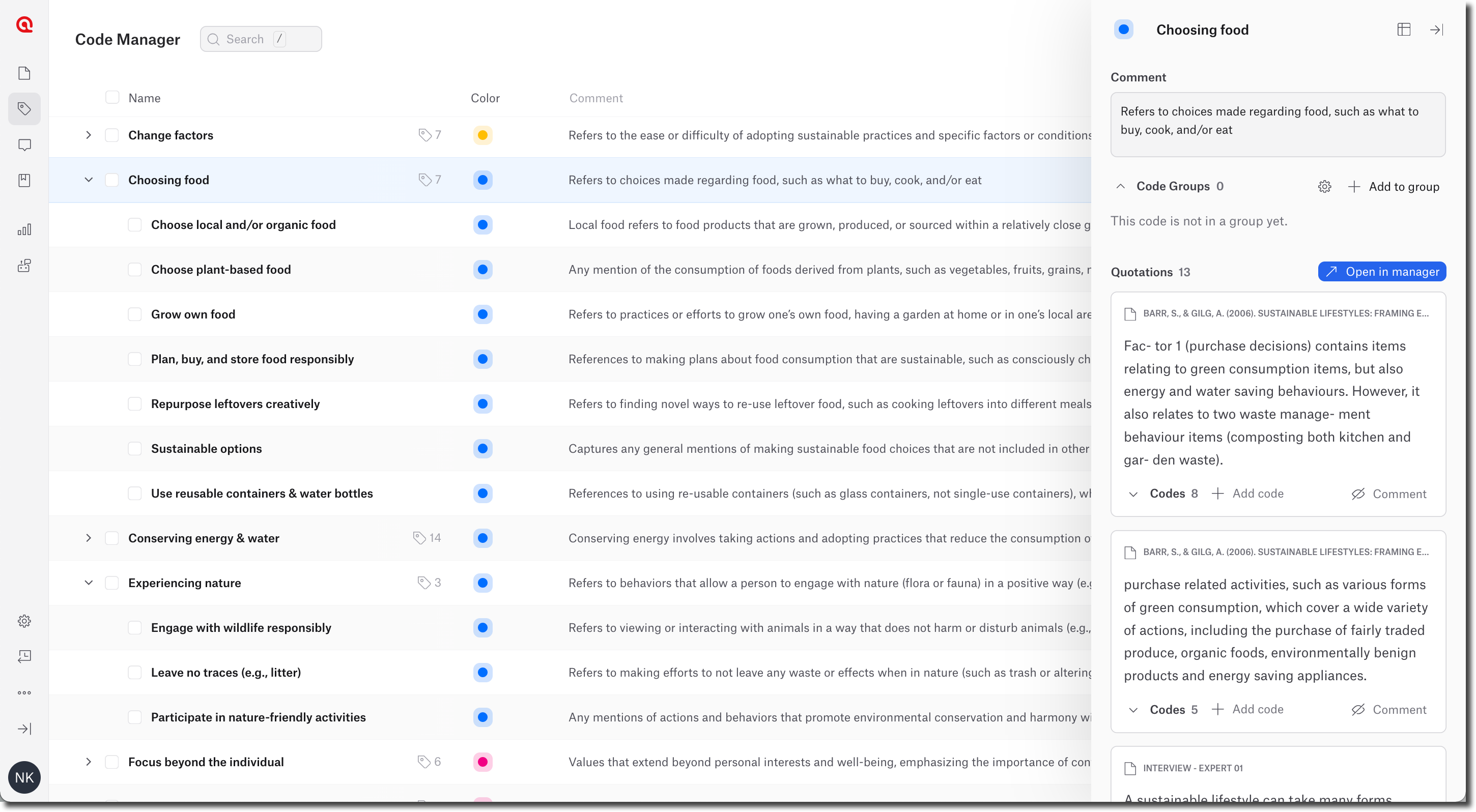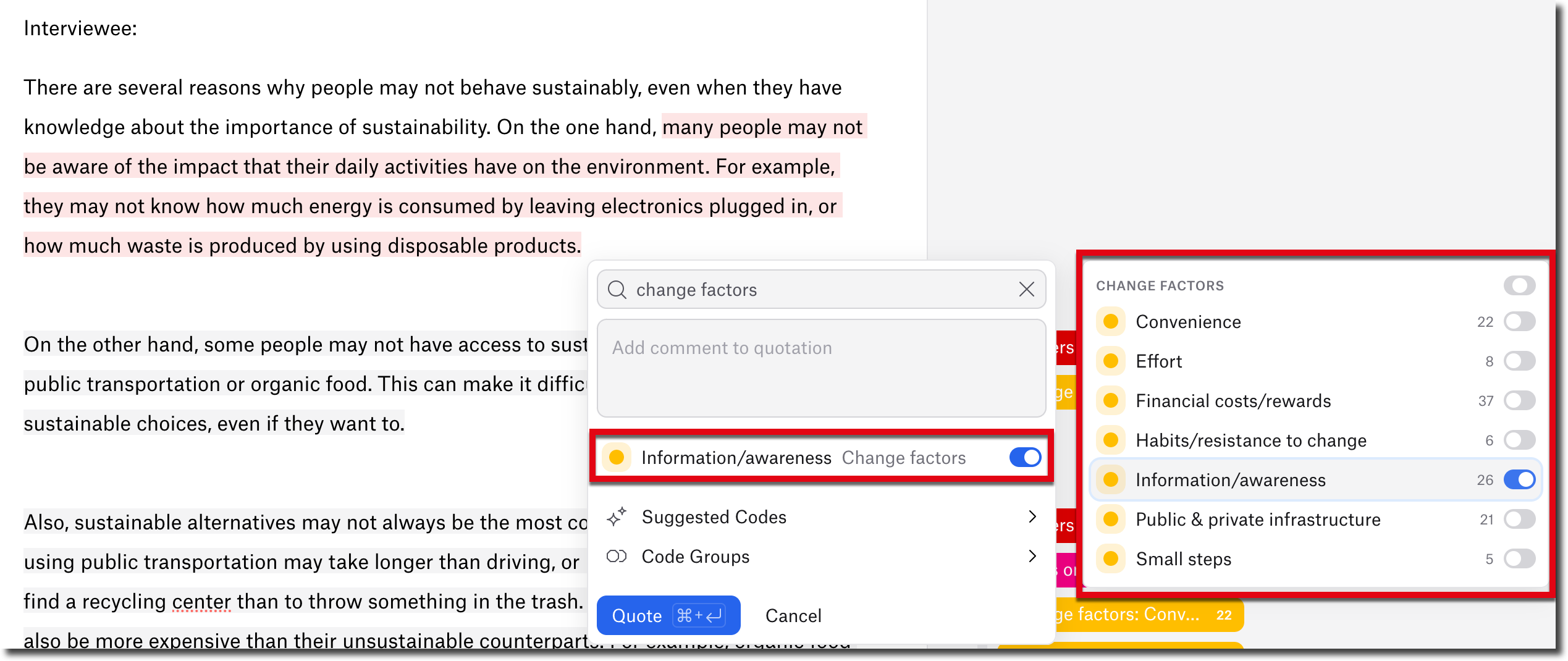How do I structure codes into categories and sub-codes in ATLAS.ti Web?
Organize your codes into a hierarchical structure with code categories and sub-codes. In this article, we explain why code categories are important in qualitative research and how you can create code categories, remove sub-codes from categories, code your data with categories, and query your coded data with categories.
Organize your codes to make sense of your analysis
In any qualitative research project, you are likely to create many different codes that capture distinct aspects of your data. Codes are essential for condensing and organizing all the rich information in qualitative data. However, it can become difficult to manage long lists of codes, which is why clear organization is crucial.
Moreover, a common practice in (inductive and deductive) qualitative research is to identify topics, themes, or categories in your codes. This structuring of codes is a key process in making sense of the coded data. Organizing your codes into categories thus helps you understand what is going on in your data and what are the main findings.

How do code categories work?
Organizing your codes into categories and sub-codes offers you greater flexibility in managing and querying your data. The code category represents a category, theme, or topic in your data. You can then designate multiple sub-codes within a code category, and these sub-codes can capture more specific details or facets of the category.
How can I create code categories and sub-codes?
Any code that does not have any quotations associated can be converted into a code category. It is important that the code used to create the category has 0 quotations, because this code will capture all of the quotations of the sub-codes under it.
Here's how it works:
- Go to the Code Manager (click on the code icon in the lefthand panel)
- You have two options for creating code categories and sub-codes:
- Drag-and-drop
- Since a code cannot have any associated quotations to be converted into a category, you can create a new code with the name of your desired category.
- Hover your mouse over a code that you would like to move under a category (i.e., hover over a code that will become a sub-code to a category).
- Click on the dotted square that appears to the left of the code name, and drag this code onto the code category (i.e., drag-and-drop the sub-code onto its category).
- Click on "Make subcode of..." from the pop-up menu. This creates the code category and stores the sub-code underneath it.
Repeat this process to move sub-codes under code categories. You can also select multiple sub-codes to drag-and-drop them onto a code category at the same time. Dragging-and-dropping can also be used to move sub-codes from one code category to another code category.

Drag-and-drop codes onto a code category to create a hierarchical structure
- Select and click
- Select one or more codes that you would like to move under a category (i.e., tick the box(es) to the left of the code(s) that will become a sub-code to a category).
- Click on the button with three dots that appears in the black menu at the bottom of the screen.
- Select "Move codes".
ATLAS.ti Web displays any already-created code categories and all codes that have 0 quotations associated, so you can select the code that will be the category. You can also create a new code from this window and designate it as the code category.

Select codes and click the "move" button to create a hierarchical structure
- Drag-and-drop
- Now you can see your codes in a hierarchical list. Click on the drop-down arrow next to a code cateogry to view its sub-codes. You can still view more details of each code in the right-hand side panel, and now if you view your category code in the side panel, you will see all the quotations associated with any of the sub-codes.
How do I remove a sub-code from a category?
You can think of code categories as "parent codes" and sub-codes as "child codes". Codes that are not part of any category, in contrast, can be seen as independent codes. Independent codes and code categories exist at the "root level" of your code hierarchy, or the first level; sub-codes exist at the second level nested within the first/root level. Removing a sub-code from a category is thus a matter of moving a sub-code back to the root/first level of codes (i.e., converting it into an independent code).
Here's how it works:
- Go to the Code Manager (click on the code icon in the lefthand panel)
- You have two options for removing sub-codes from a category:
- Drag-and-drop
- Hover your mouse over a code that you would like to remove from a category.
- Click on the dotted square that appears to the left of the code name, and drag this code onto the blue rectangle at the bottom that says "Drag here to move to root" (the root level refers to the first level of codes, which includes independent codes that are not part of any category as well as code categories).
Repeat this process to remove sub-codes from their code categories. You can also select multiple sub-codes to drag-and-drop them onto the root level all at once (i.e., remove them from their code categories).

Drag-and-drop sub-codes to the blue area to remove them from a code category
- Select and click
- Select one or more codes that you would like to remove from a category (i.e., tick the box(es) to the left of the sub-code(s) that will be removed).
- Click on the button with three dots that appears in the black menu at the bottom of the screen.
- Select "Move codes".
Select "Root Level (no parent code)" from the window that appears.

Select codes and click the "move" button to remove sub-codes from a code category
- Drag-and-drop
- Now your sub-codes have been converted to independent codes that exist outside of any code category.
How do I code my data with code categories and sub-codes?
Code categories make it easier to sift through your codes as you code your data. For example, you can search for a sub-code or code category from the coding window. When coding your data, you can attach any category sub-codes to a quotation, and the code will be automatically displayed with its category name, a colon, and the sub-code name (i.e., "Category: Sub-code").
ATLAS.ti's AI Coding also utilizes code categories to organize the resulting AI codes into overarching categories. You can thus see the main categories that were identified by the AI, and you can see more specific details about each category by viewing its sub-codes.
How to use code categories while coding your data:
- Open a document that you wish to code.
- Highlight a relevant segment of text.
- Click in the search bar ("Find or create codes") from the coding window that appears.
- ATLAS.ti Web lists all the codes in your project. If you have already created code categories, you will see your codes organized by their categories.
- You can scroll through the list of codes, or you can start typing in the search bar and ATLAS.ti will show all code names that contain the text you typed.
- Click the button to the right of any code to attach that code to the quotation. You can attach all the sub-codes of a category by clicking the button next to the code category name.

How to use code categories in AI Coding results:
- Open the AI Coding tool:
- To analyze one document, open that document and then click on "Tools - AI Coding" from the top-right corner.
- To analyze multiple documents, go to the Document Manager, select the documents you want to analyze, and then click on the "Tools" button in the black bar at the bottom of the screen and select "AI Coding".
- Click the "Start AI Coding" button (after ticking the box to accept the license agreement and privacy policy).
- Now you can see the results of the AI Coding conveniently organized by code categories. ATLAS.ti displays codes on the left-hand side, and the selected data quotations are shown on the right-hand side.
- You can choose which codes you want to attach to the quotations by clicking the button to the right of the code names. You can also choose entire code categories by clicking the button next to the code category name.
- Click the "Apply AI Coding" button in the top-right corner to attach all the selected codes to their quotations.

How can I query my code categories?
One of the greatest advantages of working with code categories is that they make it easy for you to analyze your data across different levels: You can "zoom out" to the category level to explore overarching themes, and you can "zoom in" to the sub-code level to examine more specific details.
View all quotations within a code category:
- Go to the Code Manager (click on the code icon in the lefthand panel)
- Hover your mouse over a code category and click on the "Details" button to open the right-hand side panel.
- Now you can see all all the quotations associated with any of the sub-codes.
- Click on the "Open in manager" button to view these results in the Quotation Manager. Now you can see a bar chart displaying the frequencies of the codes attached to the quotations from that code category.
Click on the "Save as View" button to save these results so that you can easily come back to them later.

View all data in a code category
Use code categories to filter your analyses or reports:
- Views in ATLAS.ti Web refer to different kinds of analyses or reports you can create to gain insights from your data. Go to the Views page (click on the views icon in the lefthand panel).
- Click "New View" and select the kind of View you would like to create (e.g., code distribution, code-document table, code co-occurrence, or concepts).
- Whenever you are selecting codes to include in a view, you will now see your codes organized by their categories. You can scroll through the list of codes, or you can start typing in the search bar and ATLAS.ti will show all code names that contain the text you typed.
- Click the button to the right of any code to attach that code to the quotation. You can attach all the sub-codes of a category by clicking the button next to the code category name.
- For example, you can include entire code categories in code-document table, code co-occurrence, or concepts views. In code distribution views, you can apply a filter rule and select code categories.






